Basic Mechanical Properties of Self-Compacting Concrete Prepared with Aeolian Sand and Recycled Coarse Aggregate
Abstract
:1. Introduction
2. Materials and Methods
2.1. Material Properties
2.1.1. Binders, Water, and Admixtures
2.1.2. Fine Aggregate
2.1.3. Coarse Aggregate
2.2. Mix Proportions of ARSCC
2.3. Test and Analysis Methods
2.3.1. Workability Tests
2.3.2. Mechanical Property Tests
2.3.3. Scanning Electron Microscopy Test
2.3.4. Mercury Intrusion Porosimetry Test
2.3.5. Range Analysis Method
3. Results and Discussion
3.1. Workability Test Results
3.2. Analysis of Workability
3.3. Mechanical Properties Test Result
3.3.1. Uniaxial Compressive Strength
3.3.2. Splitting Tensile Strength
3.3.3. Static Stress–Strain Curve
3.3.4. Axial Compressive Strength
3.4. Analysis of Mechanical Properties
4. Micro Test Result Analysis
4.1. Scanning Electron Microscopy
4.2. Mercury Intrusion Porosimetry
5. Conclusions
- (1)
- The AS and RCA replacements significantly affected the workability of ARSCC. Range analysis revealed that AS had the greatest effect on workability.
- (2)
- The AS and RCA replacements had positive and negative effects on the uniaxial compressive strength of concrete. The optimum replacement ratios of AS and RCA for the uniaxial compressive strength were 20% and 50%, respectively, resulting in a 4.22%, 10.38%, 3.31%, and 5.52% increase in the uniaxial compressive strength at 3, 7, 14, and 28 days, respectively.
- (3)
- The effects of AS and RCA replacements on split tensile strength were also twofold, and the optimal replacement ratio of A20-R50 increased the split tensile strength by 5.44%. The split tensile strength and compressive strength were well correlated, with a correlation coefficient of 0.9122.
- (4)
- The regression equations of the stress–strain curves of ARSCC were in a good relationship, with all regression correlation coefficients greater than 0.99. AS and RCA had different effects on the modulus of elasticity, peak stress, and axial compressive strength. There were different degrees of improvement in A20-R50.
- (5)
- AS and RCA improved the microstructure and altered the pore structure of ARSCC. The changes in microstructure and pore structure corresponded to the variations in mechanical properties of ARSCC.
Author Contributions
Funding
Data Availability Statement
Conflicts of Interest
Acronym List
| A | Aeolian sand |
| R | Recycled coarse aggregate |
| AS | Aeolian sand |
| RCA | Recycled coarse aggregate |
| SCC | Self-compacting concrete |
| ARSCC | Aeolian sand recycled coarse aggregate self-compacting concrete |
| fcu | Uniaxial compressive strength |
| ft | Splitting tensile strength |
| fc | Prism axial compressive |
| Et | Tangential young modulus |
References
- Martins, M.A.B.; Silva, L.R.R.; Kuffner, B.H.B.; Barros, R.M.; Melo, M.L.N.M. Behavior of High Strength Self-Compacting Concrete with Marble/Granite Processing Waste and Waste Foundry Exhaust Sand, Subjected to Chemical Attacks. Constr. Build. Mater. 2022, 323, 126492. [Google Scholar] [CrossRef]
- Mondikatti, P.; Sudharsan, N.; Praburanganathan, S.; Aruna, G. The Impact of Castoff Aggregate on the Fresh and Mechanical Behaviour of High-Range Water Reducer Administered Self-Compacting Concrete. Mater. Today Proc. 2023. [Google Scholar] [CrossRef]
- Okamura, H.; Ouchi, M. Self-Compacting Concrete. J. Adv. Concr. Technol. 2003, 1, 5–15. [Google Scholar] [CrossRef]
- Matos, P.R.D.; Foiato, M.; Prudêncio, L.R. Ecological, Fresh State and Long-Term Mechanical Properties of High-Volume Fly Ash High-Performance Self-Compacting Concrete. Constr. Build. Mater. 2019, 203, 282–293. [Google Scholar] [CrossRef]
- Madandoust, R.; Mousavi, S.Y. Fresh and Hardened Properties of Self-Compacting Concrete Containing Metakaolin. Constr. Build. Mater. 2012, 35, 752–760. [Google Scholar] [CrossRef]
- Karthik, D.; Nirmalkumar, K.; Priyadharshini, R. Characteristic Assessment of Self-Compacting Concrete with Supplementary Cementitious Materials. Constr. Build. Mater. 2021, 297, 123845. [Google Scholar] [CrossRef]
- Wu, J.; Jing, X.; Wang, Z. Uni-Axial Compressive Stress-Strain Relation of Recycled Coarse Aggregate Concrete after Freezing and Thawing Cycles. Constr. Build. Mater. 2017, 134, 210–219. [Google Scholar] [CrossRef]
- Bai, W.; Song, Z.; Yuan, C.; Guan, J.; Xie, C.; Huang, H.; Ma, Y. Study on Mechanical Properties and Damage Mechanism of Recycled Concrete Containing Silica Fume in Freeze–Thaw Environment. Constr. Build. Mater. 2023, 375, 130872. [Google Scholar] [CrossRef]
- Mandelbrot, B.B. Negative Fractal Dimensions and Multifractals. Phys. A Stat. Mech. Its Appl. 1990, 163, 306–315. [Google Scholar] [CrossRef]
- Topçu, I.B. Physical and Mechanical Properties of Concretes Produced with Waste Concrete. Cem. Concr. Res. 1997, 27, 1817–1823. [Google Scholar] [CrossRef]
- Padmini, A.K.; Ramamurthy, K.; Mathews, M.S. Influence of Parent Concrete on the Properties of Recycled Aggregate Concrete. Constr. Build. Mater. 2009, 23, 829–836. [Google Scholar] [CrossRef]
- Topçu, İ.B.; Şengel, S. Properties of Concretes Produced with Waste Concrete Aggregate. Cem. Concr. Res. 2004, 34, 1307–1312. [Google Scholar] [CrossRef]
- Xiao, J.; Falkner, H. Bond Behaviour between Recycled Aggregate Concrete and Steel Rebars. Constr. Build. Mater. 2007, 21, 395–401. [Google Scholar] [CrossRef]
- Breccolotti, M.; Materazzi, A.L. Structural Reliability of Bonding between Steel Rebars and Recycled Aggregate Concrete. Constr. Build. Mater. 2013, 47, 927–934. [Google Scholar] [CrossRef]
- Henry, M.; Pardo, G.; Nishimura, T.; Kato, Y. Balancing Durability and Environmental Impact in Concrete Combining Low-Grade Recycled Aggregates and Mineral Admixtures. Resour. Conserv. Recycl. 2011, 55, 1060–1069. [Google Scholar] [CrossRef]
- Olorunsogo, F.T.; Padayachee, N. Performance of Recycled Aggregate Concrete Monitored by Durability Indexes. Cem. Concr. Res. 2002, 32, 179–185. [Google Scholar] [CrossRef]
- Zhu, Y.-G.; Kou, S.-C.; Poon, C.-S.; Dai, J.-G.; Li, Q.-Y. Influence of Silane-Based Water Repellent on the Durability Properties of Recycled Aggregate Concrete. Cem. Concr. Compos. 2013, 35, 32–38. [Google Scholar] [CrossRef]
- Feng, C.; Cui, B.; Huang, Y.; Guo, H.; Zhang, W.; Zhu, J. Enhancement Technologies of Recycled Aggregate—Enhancement Mechanism, Influencing Factors, Improvement Effects, Technical Difficulties, Life Cycle Assessment. Constr. Build. Mater. 2022, 317, 126168. [Google Scholar] [CrossRef]
- Leite, M.B.; Figueire do Filho, J.G.L.; Lima, P.R.L. Workability Study of Concretes Made with Recycled Mortar Aggregate. Mater. Struct. 2013, 46, 1765–1778. [Google Scholar] [CrossRef]
- Liu, Q.; Han, F.; Yu, G.; Xu, P. Basic Mechanical Properties of Recycled Coarse Aggregate Self-compacting Concrete. J. Build. Mater. 2020, 23, 1053–1060. [Google Scholar]
- de Juan, M.S.; Gutiérrez, P.A. Study on the Influence of Attached Mortar Content on the Properties of Recycled Concrete Aggregate. Constr. Build. Mater. 2009, 23, 872–877. [Google Scholar] [CrossRef]
- Gao, S.; Liu, Q.; Han, F.; Fu, Y. Mix Design of Recycled Coarse Aggregate Self-Compacting Concrete Based on Orthogonal Test and Analysis of Mercury Intrusion Porosimetry. Adv. Mater. Sci. Eng. 2021, 2021, 4829673. [Google Scholar] [CrossRef]
- Safiuddin, M.; Salam, M.A.; Jumaat, M.Z. Effects of Recycled Concrete Aggregate on the Fresh Properties of Self-Consolidating Concrete. Arch. Civ. Mech. Eng. 2011, 11, 1023–1041. [Google Scholar] [CrossRef]
- Chu, H.; Wang, F.; Wang, L.; Feng, T.; Wang, D. Mechanical Properties and Environmental Evaluation of Ultra-High-Performance Concrete with Aeolian Sand. Materials 2020, 13, 3148. [Google Scholar] [CrossRef]
- Bendixen, M.; Best, J.; Hackney, C.; Iversen, L.L. Time Is Running out for Sand. Nature 2019, 571, 29–31. [Google Scholar] [CrossRef]
- Bai, J.; Zhao, Y.; Shi, J.; He, X. Damage Degradation Model of Aeolian Sand Concrete under Freeze–Thaw Cycles Based on Macro-Microscopic Perspective. Constr. Build. Mater. 2022, 327, 126885. [Google Scholar] [CrossRef]
- Li, Y.; Zhang, H.; Liu, G.; Hu, D.; Ma, X. Multi-Scale Study on Mechanical Property and Strength Prediction of Aeolian Sand Concrete. Constr. Build. Mater. 2020, 247, 118538. [Google Scholar] [CrossRef]
- Li, X.A.; Zheng, H.F.; Li, X.X.; Ye, W.J. Test on the Mortar Mix Ratio with Aeolian Sand of Mu Us Desert. Adv. Mater. Res. 2011, 152–153, 892–896. [Google Scholar] [CrossRef]
- Damene, Z.; Goual, M.S.; Houessou, J.; Dheilly, R.M.; Goullieux, A.; Quéneudec, M. The Use of Southern Algeria Dune Sand in Cellular Lightweight Concrete Manufacturing: Effect of Lime and Aluminium Content on Porosity, Compressive Strength and Thermal Conductivity of Elaborated Materials. Eur. J. Environ. Civ. Eng. 2018, 22, 1273–1289. [Google Scholar] [CrossRef]
- Seif, E.; Sedek, E. Performance of Cement Mortar Made with Fine Aggregates of Dune Sand, Kharga Oasis, Western Desert, Egypt: An Experimental Study. Jordan J. Civ. Eng. 2013, 7, 270–284. [Google Scholar]
- Seif, E.-S.S.A. Assessing the Engineering Properties of Concrete Made with Fine Dune Sands: An Experimental Study. Arab. J. Geosci. 2013, 6, 857–863. [Google Scholar] [CrossRef]
- Lynda Amel, C.; Kadri, E.-H.; Sebaibi, Y.; Soualhi, H. Dune Sand and Pumice Impact on Mechanical and Thermal Lightweight Concrete Properties. Constr. Build. Mater. 2017, 133, 209–218. [Google Scholar] [CrossRef]
- Luo, F.J.; He, L.; Pan, Z.; Duan, W.H.; Zhao, X.L.; Collins, F. Effect of Very Fine Particles on Workability and Strength of Concrete Made with Dune Sand. Constr. Build. Mater. 2013, 47, 131–137. [Google Scholar] [CrossRef]
- Al-Harthy, A.S.; Halim, M.A.; Taha, R.; Al-Jabri, K.S. The Properties of Concrete Made with Fine Dune Sand. Constr. Build. Mater. 2007, 21, 1803–1808. [Google Scholar] [CrossRef]
- GB175-2007; Common Portland Cement. Standards Press of China: Beijing, China, 2007.
- GB/T 1596-2017; Fly Ash Used for Cement and Concrete. Standards Press of China: Beijing, China, 2017.
- Han, X.; Liu, Q.; Han, F.; Deng, P. Experimental Study on Aeolian Sand Self-compacting Concrete Based on Orthogonal Experiment. Concrete 2021, 5, 113–118. [Google Scholar]
- Yan, H.; Liu, Q.; Han, F.; Liu, S.; Han, T.; He, B. Frost Durability of Self-Compacting Concrete Prepared with Aeolian Sand and Recycled Coarse Aggregate. Materials 2023, 16, 6393. [Google Scholar] [CrossRef]
- Zheng, S.; Liu, Q.; Han, F.; Liu, S.; Zhang, G.; Zhu, J. Impermeability and Durability of Self-Compacting Concrete Prepared with Aeolian Sand and Recycled Coarse Aggregate. Materials 2023, 16, 7279. [Google Scholar] [CrossRef]
- Ning, J. Study on Bending Test of C30 Recycled Coarse Aggregate Self-compacting Concrete Simple Supported Beam after Freeze-Thaw Cycle. Master’s Thesis, Xinjiang University, Urumqi, China, 2019. [Google Scholar]
- T/CECS 203-2021; Technical Specification for Application of Self-Compacting Concrete. China Architecture & Building Press: Beijing, China, 2021.
- GB/T 50081-2019; Standard for Test Methods of Concrete Physical and Mechanical Properties. China Architecture & Building Press: Beijing, China, 2019.
- GB/T 21650.1-2008; Pore Size Distribution and Porosity of Solid Materials by Mercury Porosimetry and Gas Adsorption—Part 1: Mercury Porosimetry. Standards Press of China: Beijing, China, 2008.
- Guo, Z. Strength and Deformation of Concrete: Test Basis and Constitutive Relation; Tsinghua University Press: Beijing, China, 1997. [Google Scholar]
- Li, Q.; Feng, Q.; Cao, H. Effects of recycled aggregates gradation on mechanical performance of concrete and microscopic performance analysis. J. Jiangsu Univ. Nat. Sci. Ed. 2019, 40, 614–620. [Google Scholar]
- Li, F.; Ye, Z.; Zhao, R. Microstructural analysis of recycled-aggregate concrete. Concrete 2008, 5, 30–33. [Google Scholar]
- Li, Y.; Li, J. Capillary Tension Theory for Prediction of Early Autogenous Shrinkage of Self-Consolidating Concrete. Constr. Build. Mater. 2014, 53, 511–516. [Google Scholar] [CrossRef]
- Chen, B.; Peng, L.; Zhong, H.; Zhao, Y.; Meng, T.; Zhang, B. Improving the Mechanical Properties of Mussel Shell Aggregate Concrete by Aggregate Modification and Mixture Design. Case Stud. Constr. Mater. 2023, 18, e02017. [Google Scholar] [CrossRef]





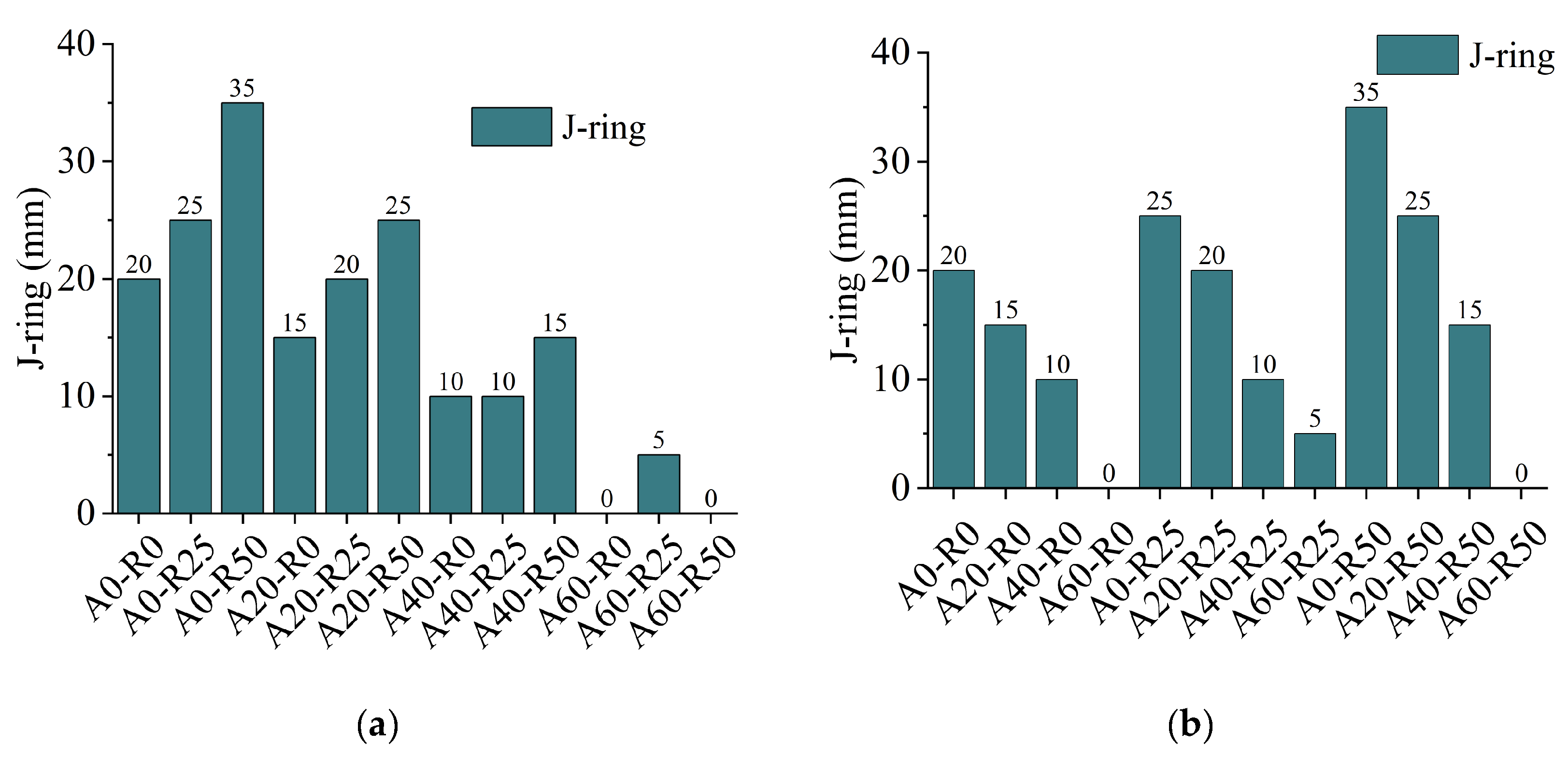
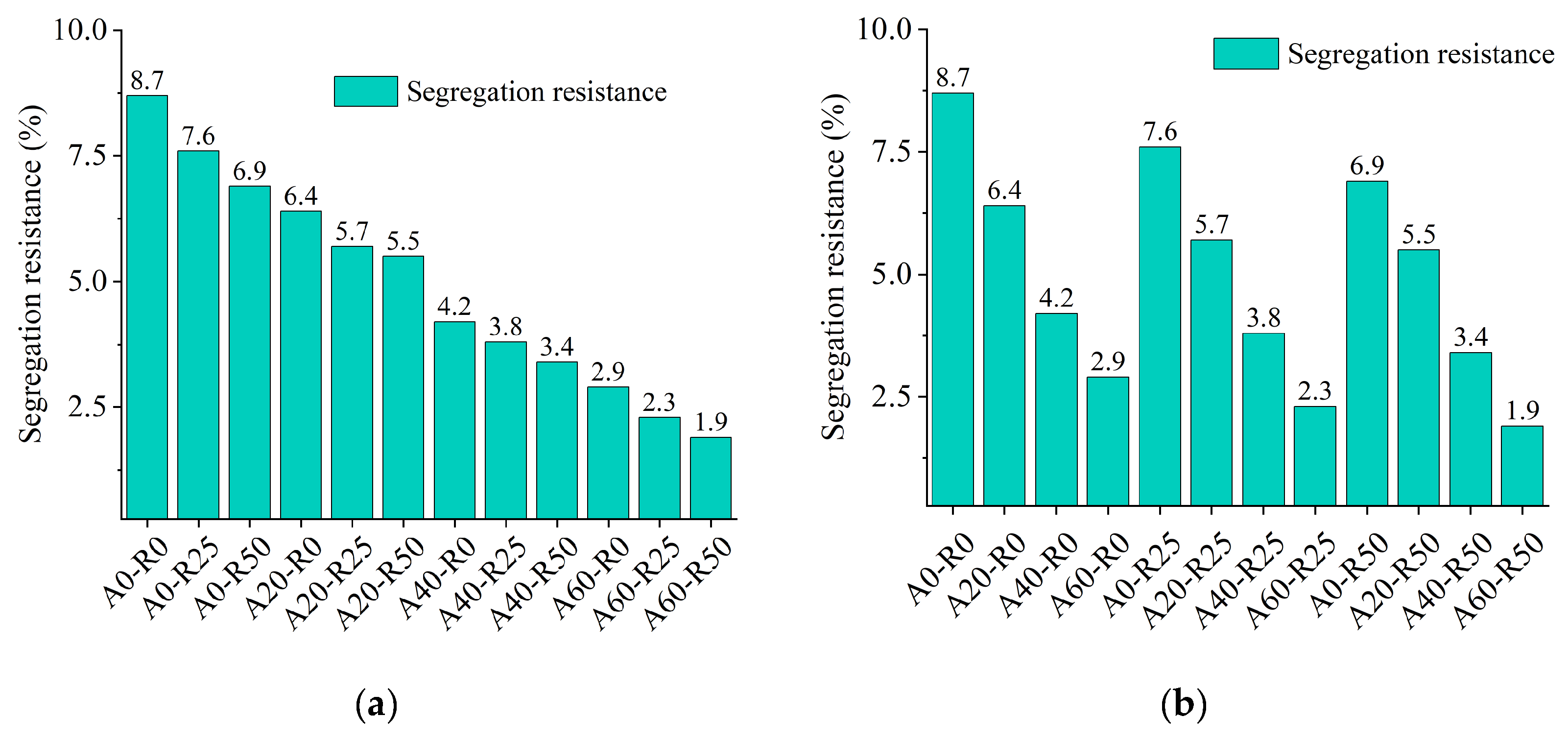

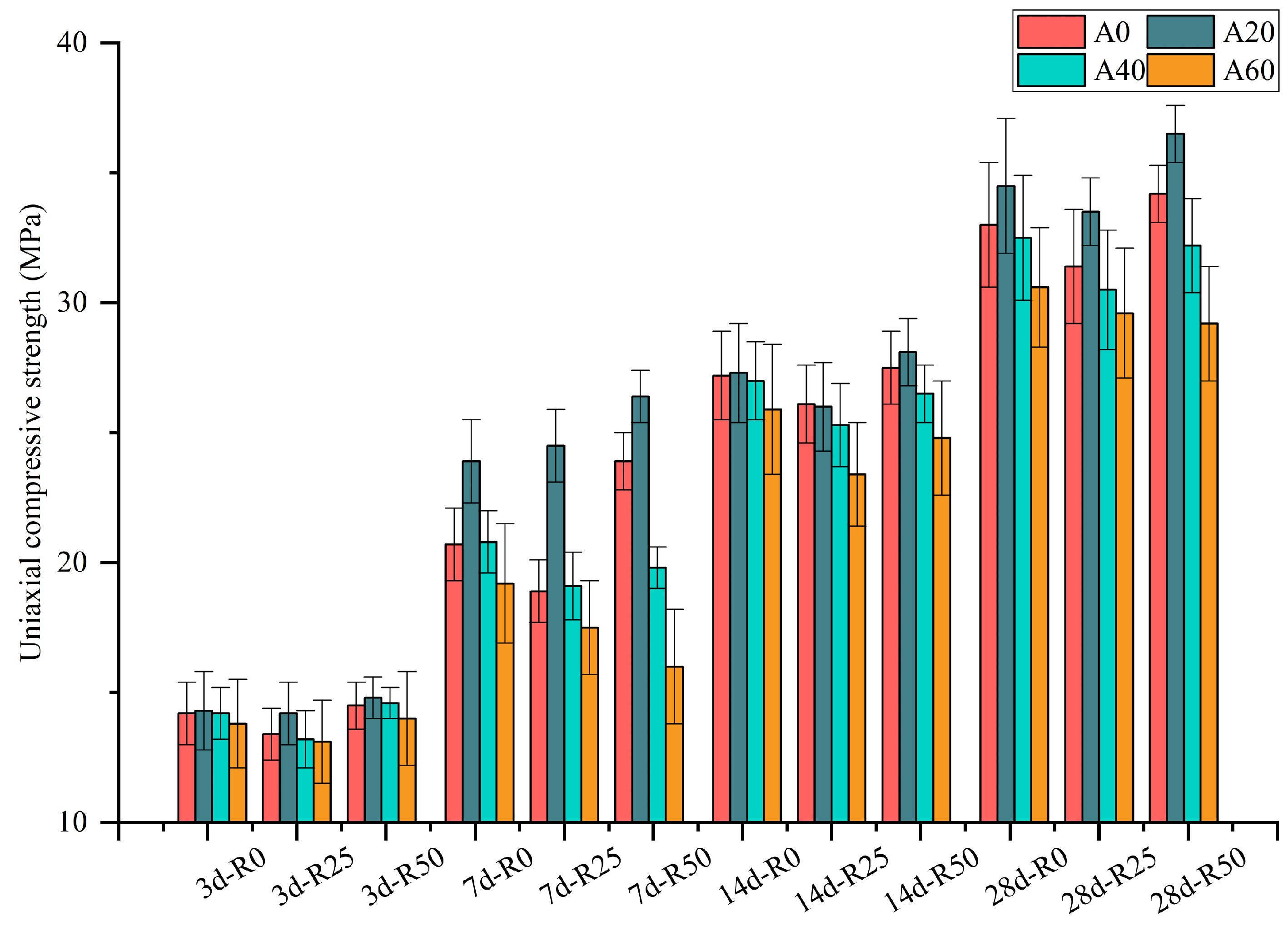



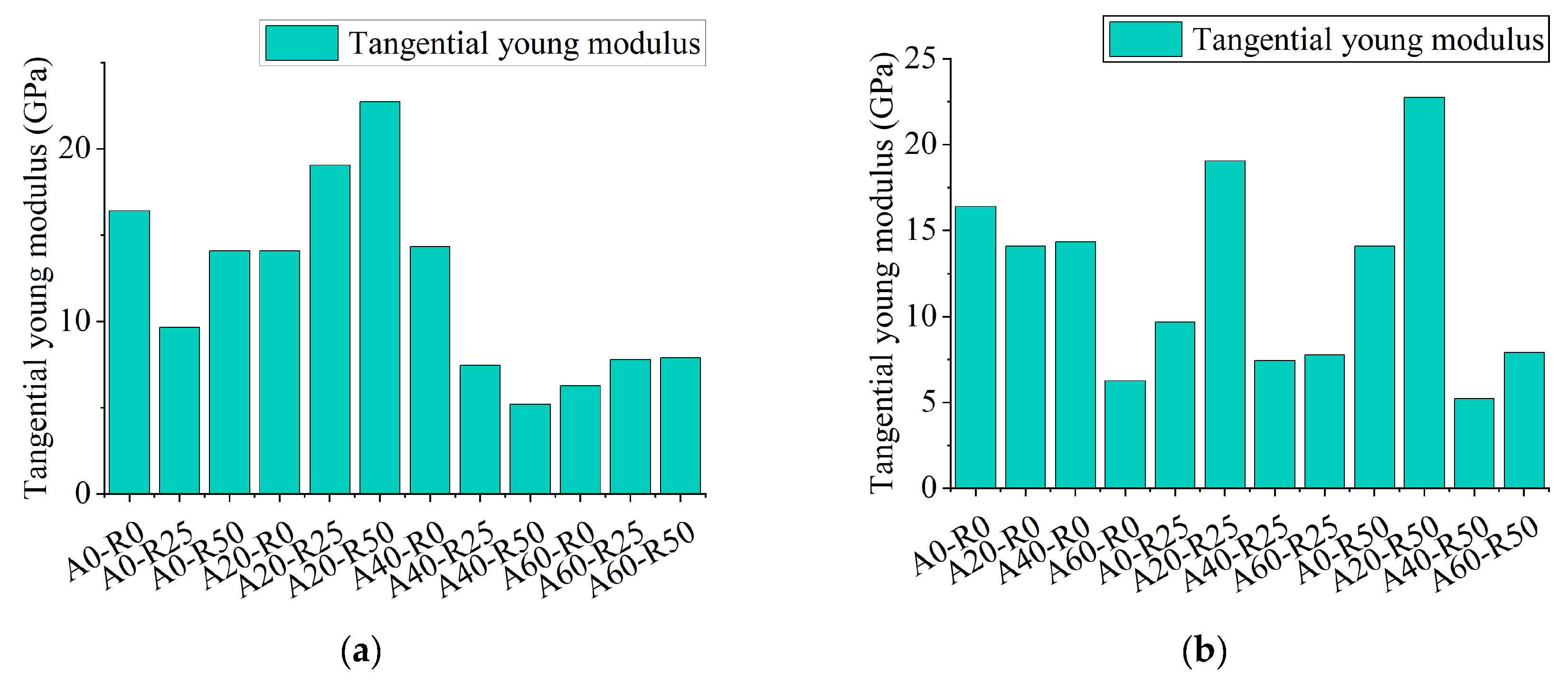

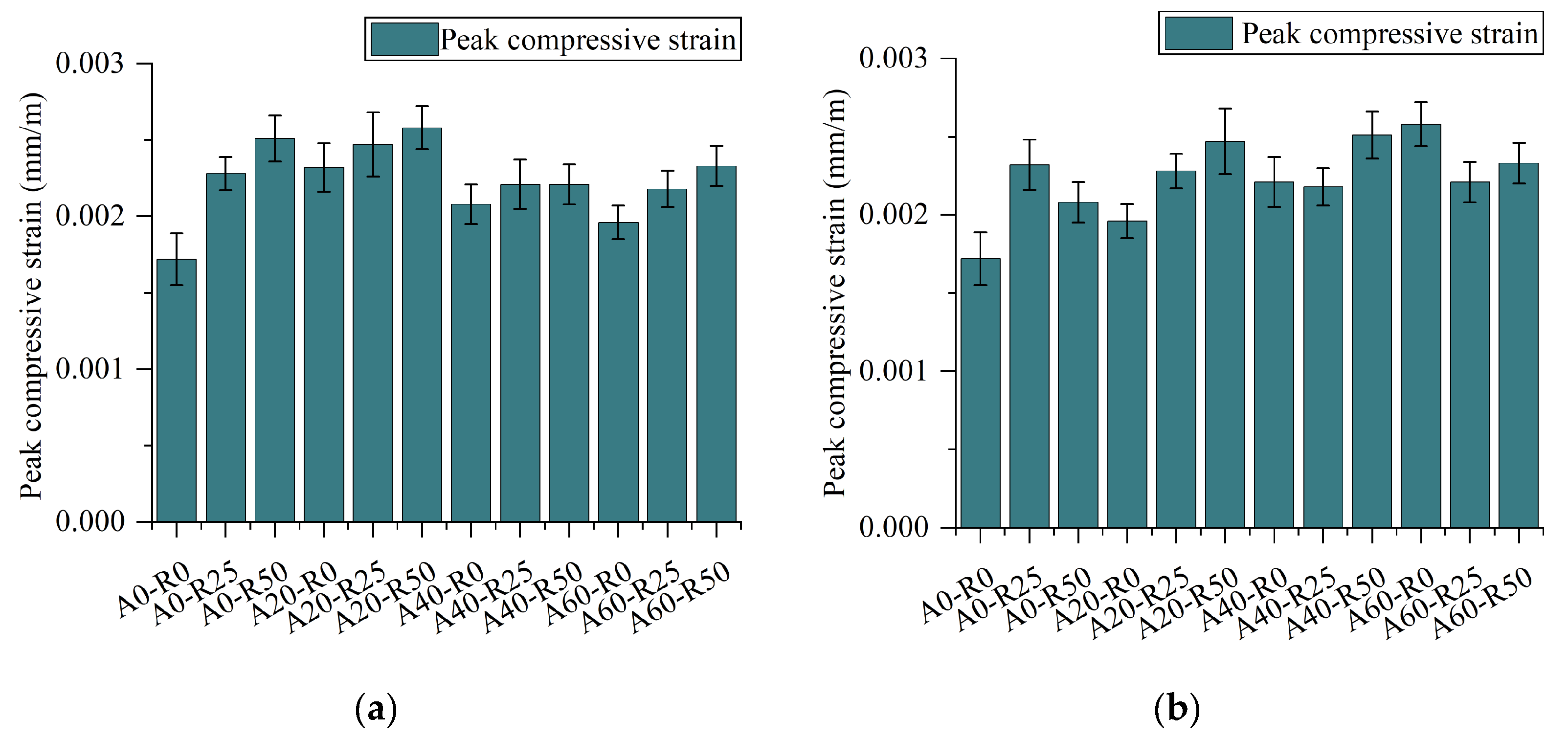



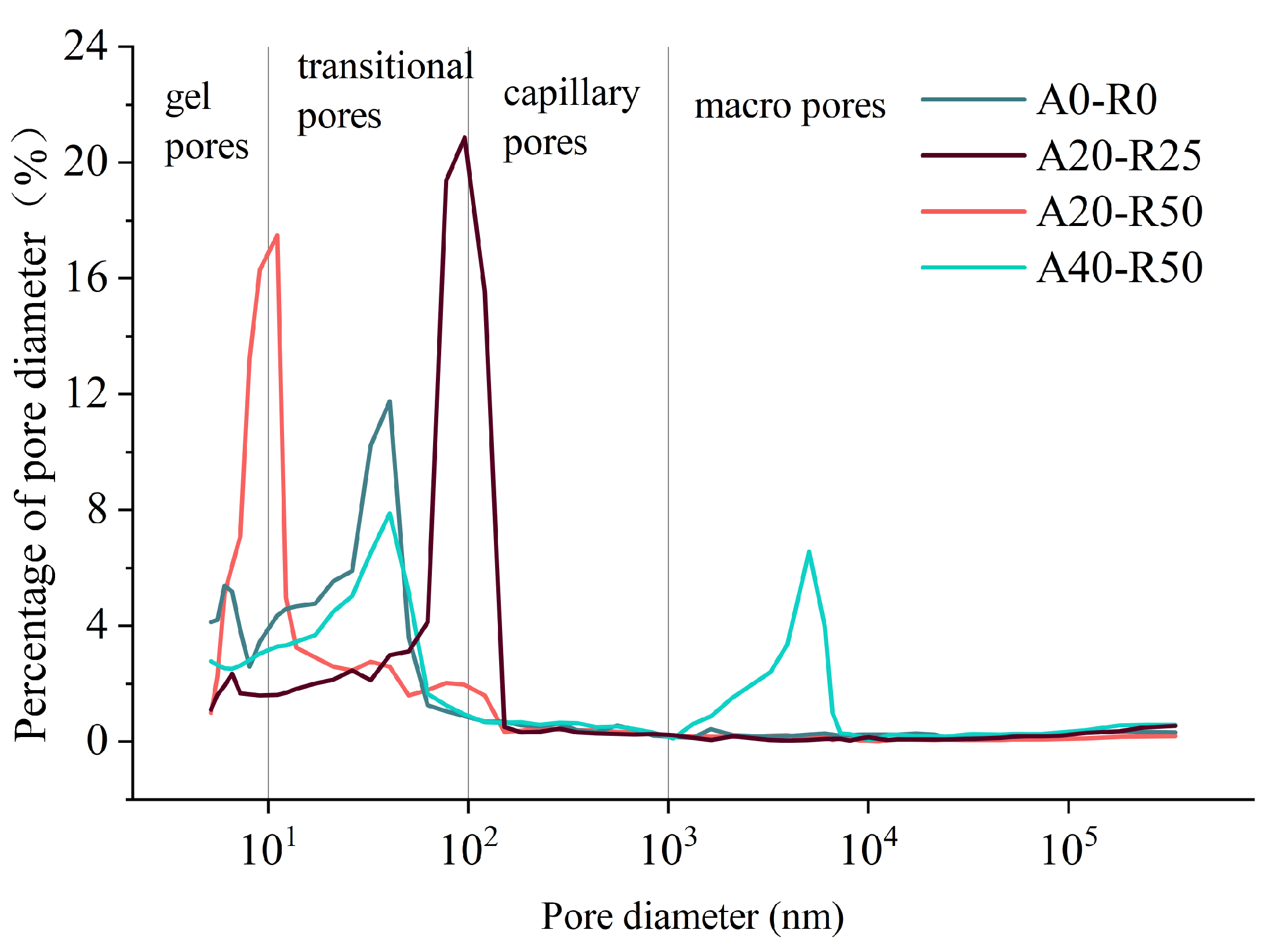
| Cement Stability | Fineness (Sieve Size: 80 μm)/% | Specific Surface (m2/kg) | Setting Time (min) | Compressive Strength (MPa) | ||
|---|---|---|---|---|---|---|
| Initial | Final | 3 d | 28 d | |||
| Qualified | 0.6 | 360 | 85 | 210 | 27.8 | 48 |
| Ingredient | SiO2 | Al2O3 | Fe2O3 | CaO | Na2O | MgO | K2O | SO3 |
|---|---|---|---|---|---|---|---|---|
| Content | 50.79 | 15.92 | 11.10 | 10.29 | 3.52 | 2.60 | 2.22 | 1.43 |
| Fineness (%) | Moisture Content (%) | Water Demand Ratio (%) | Ignition Loss Rate (%) |
|---|---|---|---|
| 22.2 | 0.1 | 91 | 3.1 |
| Samples | SiO2 | Al2O3 | CaO | Fe2O3 | Na2O | K2O | MgO | TiO2 | P2O5 | SO3 | Other |
|---|---|---|---|---|---|---|---|---|---|---|---|
| AS | 75.09 | 11.16 | 3.66 | 3.13 | 2.68 | 2.34 | 0.96 | 0.65 | 0.16 | 0.03 | 0.14 |
| NS | 90.76 | 4.59 | 0.11 | 0.73 | 0.39 | 2.2 | 0.18 | 0.14 | 0.07 | 0.07 | 0.76 |
| Sand | Source | Technical Indicators | ||
|---|---|---|---|---|
| Fineness Modulus | Soil Clay Content (%) | Apparent Density (kg/m3) | ||
| AS | Gurbantunggut Desert | 0.12 | 2.60 | 2542.40 |
| NS | Urumqi sand field | 2.93 | 0.80 | 2487.50 |
| Aggregate Category | Water Absorption (%) | Moisture Content (%) | Packing Density (kg/m3) | Apparent Density (kg/m3) | Elongated Particle (%) | Crush Index (%) |
|---|---|---|---|---|---|---|
| NCA | 2.36 | 0.81 | 1204.27 | 2485.25 | 1.58 | 10.44 |
| RCA | 3.60 | 0.40 | 1353.00 | 2687.22 | 3.15 | 8.76 |
| Mix Code | Fly Ash | Cement | RCA | NCA | AS | NS | Water | W/B | Added Water | WR |
|---|---|---|---|---|---|---|---|---|---|---|
| A0-R0 | 259.37 | 257.71 | 0.00 | 848.00 | 0.00 | 706.86 | 169.95 | 0.33 | 0.00 | 3.33 |
| A0-R25 | 259.37 | 257.71 | 199.94 | 636.00 | 0.00 | 706.86 | 169.95 | 0.33 | 13.89 | 3.33 |
| A0-R50 | 259.37 | 257.71 | 399.89 | 424.00 | 0.00 | 706.86 | 169.95 | 0.33 | 27.77 | 3.33 |
| A20-R0 | 259.37 | 257.71 | 0.00 | 848.00 | 140.8 | 565.49 | 169.95 | 0.33 | 0.00 | 3.33 |
| A20-R25 | 259.37 | 257.71 | 199.94 | 636.00 | 140.8 | 565.49 | 169.95 | 0.33 | 13.89 | 3.33 |
| A20-R50 | 259.37 | 257.71 | 399.89 | 424.00 | 140.8 | 565.49 | 169.95 | 0.33 | 27.77 | 3.33 |
| A40-R0 | 259.37 | 257.71 | 0.00 | 848 | 281.7 | 424.12 | 169.95 | 0.33 | 0.00 | 3.33 |
| A40-R25 | 259.37 | 257.71 | 199.94 | 636.00 | 281.7 | 424.12 | 169.95 | 0.33 | 13.89 | 3.33 |
| A40-R50 | 259.37 | 257.71 | 399.89 | 424.00 | 281.7 | 424.12 | 169.95 | 0.33 | 27.77 | 3.33 |
| A60-R0 | 259.37 | 257.71 | 0.00 | 848.00 | 422.6 | 282.74 | 169.95 | 0.33 | 0.00 | 3.33 |
| A60-R25 | 259.37 | 257.71 | 199.94 | 636.00 | 422.6 | 282.74 | 169.95 | 0.33 | 13.89 | 3.33 |
| A60-R50 | 259.37 | 257.71 | 399.89 | 424.00 | 422.6 | 282.74 | 169.95 | 0.33 | 27.77 | 3.33 |
| Factor | K1 | K2 | K3 | K4 |
|---|---|---|---|---|
| A | A0-R0 | A20-R0 | A40-R0 | A60-R0 |
| A0-R25 | A20-R25 | A40-R25 | A60-R25 | |
| A0-R50 | A20-R50 | A40-R50 | A60-R50 | |
| R | A0-R0 | A0-R25 | A0-R50 | - |
| A20-R0 | A20-R25 | A20-R50 | - | |
| A40-R0 | A40-R25 | A40-R50 | - | |
| A60-R0 | A60-R25 | A60-R50 | - |
| Workability Test | Factors | K1 | K2 | K3 | K4 | 1 | 2 | 3 | 4 | R |
|---|---|---|---|---|---|---|---|---|---|---|
| Slump-flow | A | 1844 | 1800 | 1749 | 1623 | 614.67 | 600.00 | 583.00 | 541.00 | 73.67 |
| R | 2440 | 2343 | 2233 | 610.00 | 585.75 | 558.25 | 51.75 | |||
| J-ring | A | 30 | 19 | 18 | 7 | 10.00 | 6.33 | 6.00 | 2.33 | 7.67 |
| R | 33 | 25 | 16 | 8.25 | 6.25 | 4.00 | 4.25 | |||
| Segregation resistance | A | 42 | 26 | 21 | 12 | 26.93 | 27.13 | 26.27 | 24.70 | 10.00 |
| R | 33 | 30 | 38 | 8.25 | 7.50 | 9.50 | 2.00 |
| Mix Code | Mechanical Properties Test Results | |||||
|---|---|---|---|---|---|---|
| 3 d fcu (MPa) | 7 d fcu (MPa) | 14 d fcu (MPa) | 28 d fcu (MPa) | 28 d fc (MPa) | 28 d ft (MPa) | |
| A0-R0 | 14.2 | 20.7 | 27.2 | 33.0 | 24.8 | 4.18 |
| A0-R25 | 13.4 | 18.9 | 26.1 | 31.4 | 22.9 | 3.52 |
| A0-R50 | 14.5 | 23.9 | 27.5 | 34.2 | 26.0 | 3.36 |
| A20-R0 | 14.3 | 23.9 | 27.3 | 34.5 | 26.7 | 4.64 |
| A20-R25 | 14.2 | 24.5 | 26.0 | 33.5 | 25.1 | 3.76 |
| A20-R50 | 14.8 | 26.4 | 28.1 | 36.5 | 29.3 | 3.54 |
| A40-R0 | 14.2 | 20.8 | 27.0 | 32.5 | 24.1 | 3.46 |
| A40-R25 | 13.2 | 19.1 | 25.3 | 30.5 | 21.7 | 3.64 |
| A40-R50 | 14.6 | 19.8 | 26.5 | 32.2 | 22.1 | 3.30 |
| A60-R0 | 13.8 | 19.2 | 25.9 | 30.6 | 21.7 | 3.14 |
| A60-R25 | 13.1 | 17.5 | 23.4 | 29.6 | 20.4 | 3.02 |
| A60-R50 | 14.0 | 16.0 | 24.8 | 29.2 | 19.2 | 2.88 |
| Mix Code | α1 | β1 | R2 |
|---|---|---|---|
| A0-R0 | 1.808 | 6.767 | 0.999 |
| A0-R25 | 1.930 | 3.776 | 0.998 |
| A0-R50 | 1.876 | 4.840 | 0.998 |
| A20-R0 | 1.593 | 5.686 | 0.998 |
| A20-R25 | 1.920 | 4.818 | 0.998 |
| A20-R50 | 1.706 | 3.908 | 0.992 |
| A40-R0 | 1.196 | 1.998 | 0.989 |
| A40-R25 | 1.561 | 7.732 | 0.998 |
| A40-R50 | 1.434 | 2.857 | 0.992 |
| A60-R0 | 1.257 | 1.906 | 0.994 |
| A60-R25 | 1.640 | 3.765 | 0.997 |
| A60-R50 | 1.821 | 2.925 | 0.996 |
| Mechanical Properties Test | Factors | K1 | K2 | K3 | K4 | 1 | 2 | 3 | 4 | R |
|---|---|---|---|---|---|---|---|---|---|---|
| 3 d fcu | AS | 42.1 | 43.3 | 42 | 40.9 | 14.03 | 14.43 | 14.00 | 13.63 | 0.80 |
| RCA | 56.5 | 53.9 | 57.9 | 14.13 | 13.48 | 14.48 | 1.00 | |||
| 7 d fcu | AS | 63.5 | 74.8 | 59.7 | 52.7 | 21.17 | 24.93 | 19.90 | 17.57 | 7.37 |
| RCA | 84.6 | 80 | 86.1 | 21.15 | 20.00 | 21.53 | 1.53 | |||
| 14 d fcu | AS | 80.8 | 81.4 | 78.8 | 74.1 | 26.93 | 27.13 | 26.27 | 24.70 | 2.43 |
| RCA | 107.4 | 100.8 | 106.9 | 26.85 | 25.20 | 26.73 | 1.65 | |||
| 28 d fcu | AS | 98.6 | 104.5 | 95.2 | 89.4 | 32.87 | 34.83 | 31.73 | 29.80 | 5.03 |
| RCA | 130.6 | 125 | 132.1 | 32.65 | 31.25 | 33.03 | 1.78 | |||
| 28 d fc | AS | 73.7 | 81.1 | 67.9 | 61.3 | 24.57 | 27.03 | 22.63 | 20.43 | 6.60 |
| RCA | 97.3 | 90.1 | 96.6 | 24.33 | 22.53 | 24.15 | 1.80 | |||
| 28 d ft | AS | 11.06 | 11.94 | 10.4 | 9.04 | 3.69 | 3.98 | 3.47 | 3.01 | 0.97 |
| RCA | 15.42 | 13.94 | 13.08 | 3.86 | 3.49 | 3.27 | 0.59 |
| Samples | Porosity (%) | Total Pore Area (nm2) | Average Pore Diameter (nm) | Intermediate Pore Diameter (nm) |
|---|---|---|---|---|
| A0-R0 | 20.8 | 43.3755 | 6.7107 | 21.11 |
| A20-R25 | 12.6 | 10.5872 | 1.5301 | 36.4 |
| A20-R50 | 10.3 | 8.1338 | 1.1192 | 50.4 |
| A40-R50 | 20.2 | 22.9284 | 2.3321 | 26.3 |
Disclaimer/Publisher’s Note: The statements, opinions and data contained in all publications are solely those of the individual author(s) and contributor(s) and not of MDPI and/or the editor(s). MDPI and/or the editor(s) disclaim responsibility for any injury to people or property resulting from any ideas, methods, instructions or products referred to in the content. |
© 2024 by the authors. Licensee MDPI, Basel, Switzerland. This article is an open access article distributed under the terms and conditions of the Creative Commons Attribution (CC BY) license (https://creativecommons.org/licenses/by/4.0/).
Share and Cite
Zheng, S.; Liu, Q.; Han, F.; Liu, S.; Han, T.; Yan, H. Basic Mechanical Properties of Self-Compacting Concrete Prepared with Aeolian Sand and Recycled Coarse Aggregate. Buildings 2024, 14, 2949. https://doi.org/10.3390/buildings14092949
Zheng S, Liu Q, Han F, Liu S, Han T, Yan H. Basic Mechanical Properties of Self-Compacting Concrete Prepared with Aeolian Sand and Recycled Coarse Aggregate. Buildings. 2024; 14(9):2949. https://doi.org/10.3390/buildings14092949
Chicago/Turabian StyleZheng, Shiqi, Qing Liu, Fengxia Han, Shan Liu, Tong Han, and Hao Yan. 2024. "Basic Mechanical Properties of Self-Compacting Concrete Prepared with Aeolian Sand and Recycled Coarse Aggregate" Buildings 14, no. 9: 2949. https://doi.org/10.3390/buildings14092949





